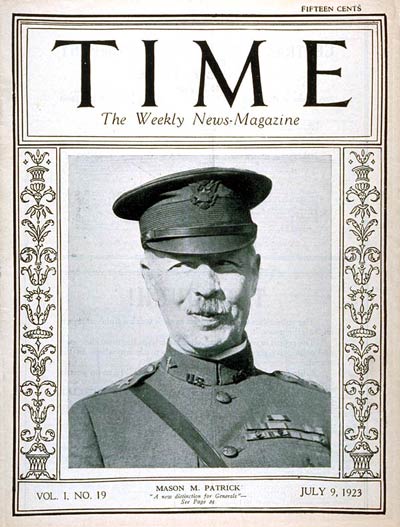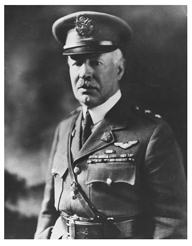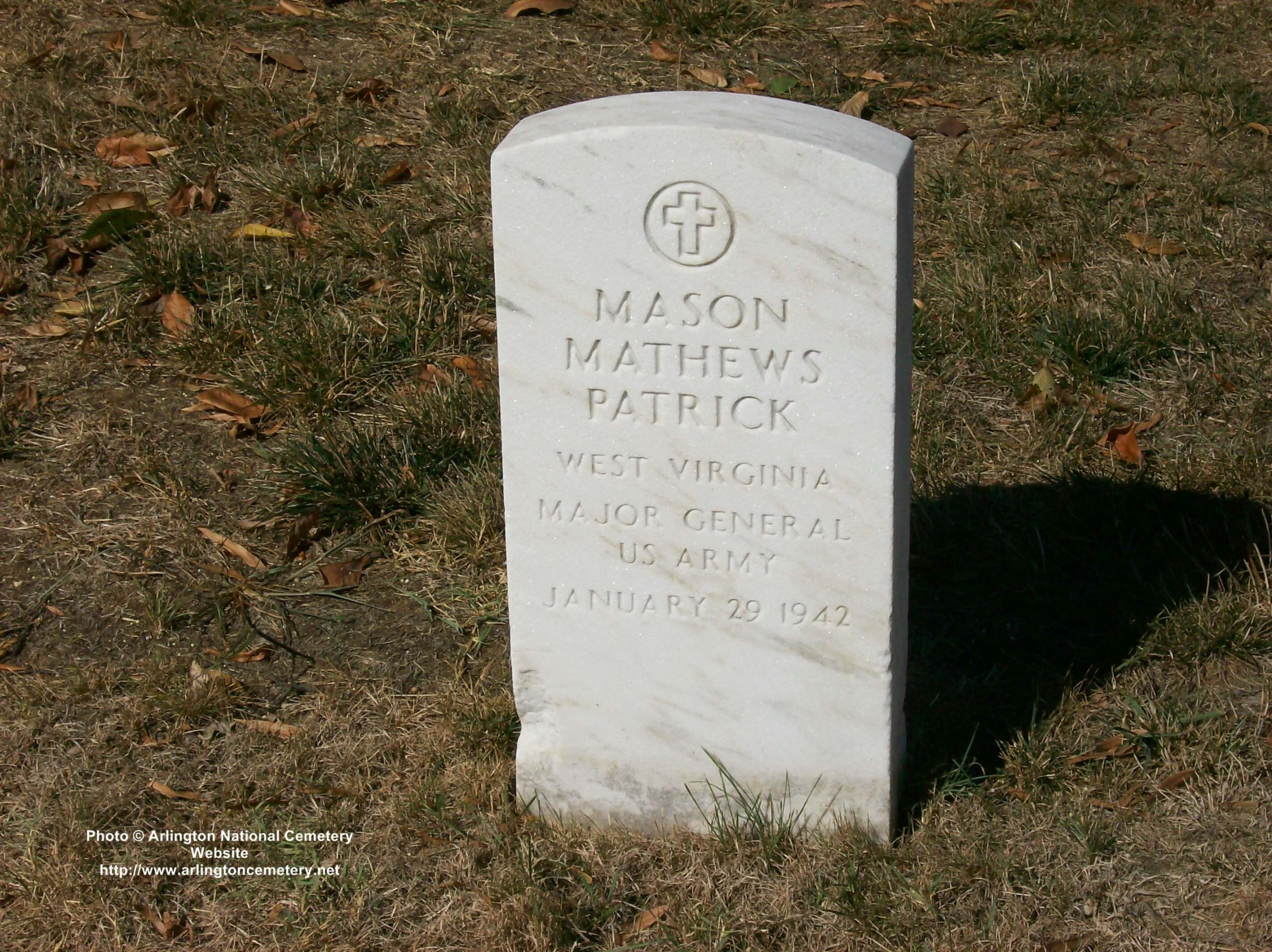Mason Mathews Patrick was born at Lewisburg, West Virginia, December 13, 1863. He graduated from West Point in 1886 and was commissioned in the Engineers. For three years he was at the Engineers School of Application, Willetts Point (later Fort Totten), New York, graduating in 1889 and receiving promotion to First Lieutenant in July. In that year he joined relief efforts following the flood at Johnstown, Pennsylvania, in May 31.
From 1892 to 1895 he taught engineering at West Point. From 1897 to 1901 he was involved in Mississippi River improvements, advancing to Captain in May 1898. After two years in the office of the Chief of Engineers he returned to the West Point faculty in 1903-06. Promoted to Major in April 1904, he was assigned in 1907-09 as Chief Engineer for the Army of Cuban Pacification. From 1909 to 1912 he was engaged in river and harbor work in Virginia, becoming a Lieutenant Colonel in 1910.
In 1910-12, he was also a member of a board directing the raising of the USS Maine in Havana Harbor. He was in river and harbor work in Michigan, 1912-16, and was promoted to Colonel of the 1st Engineer Regiment in March 1916. He served on the Mexican Border in that year and in 1917 was sent to France for World War I duty. In August he was promoted to temporary Brigadier General and in September was named Chief Engineer of Lines of Communication and Director of Construction and Forestry of the American Expeditionary Forces (AEF).
In May 1918 he was appointed by General John J. Pershing to command the combined Air Service of the AEF, until then an uncoordinated collection of often competing units attached to Army and Corps staffs. In June he was advanced to temporary Major General. He remained with the Air Service until June 1919, returning then to the U.S. and to various engineering duties, including Assistant Chief of Engineers in 1920-21. In October 1921, he was promoted to Major General and appointed Chief of the Air Service and, the better to execute his responsibilities, he learned how to fly. Under his direction the Air Service established experimental facilities at Wright Field, Ohio, and a large training facility at San Antonio, Texas. The Air Service made great progress in aircraft design and doctrine and its pilots set innumerable speed, distance and altitude records. During April-September 1924, a team of Army pilots in Douglas Liberty 400 bombers made the first around-the-world flight, covering 26,345 miles in 363 hours of flying over a span of 175 days and winning the Collier Trophy for the Air Service. In 1925, he sat on the court martial of his former assistant, Colonel William Mitchell. As a result of urging by Mitchell and Patrick, among others, the Air Service was reorganized as the Air Corps in July 1926, receiving an additional degree of autonomy under an Assistant Secretary of War.
He was reappointed Chief of the Air Service in October 1925 and retired from the Army in December 1927. The following year he published “The U.S. In the Air.” From 1929 to 1933 he was Public Utilities Commissioner for the District of Columbia.
He died in Washington, D.C. on January 29, 1942 and was buried in Section 6 of Arlington National Cemetery on January 31, 1942.
Mason Patrick was the first real head of American aviation. Although an Army engineer for 30 years, in 1918 General John J. Pershing, Patrick’s West Point classmate, appointed him as commander of the Air Service in France. In Pershing’s words, there were many fine people in the air arm, but they were “running around in circles”; he wanted Patrick to make them go straight. Although knowing virtually nothing about aviation at that point, Patrick was an excellent organizer and administrator.
By the end of the war, the Air Service was an efficient and well run combat arm. After the armistice, Patrick returned to the Corps of Engineers, but in late 1921 he was recalled to the Air Service. His predecessor, Charles Menoher, could not get along with the most famous airman of the day, William (“Billy”) Mitchell, and, in the resulting power struggle, Menoher lost. Because Patrick had managed the difficult airman during the war, he was given the opportunity to do so again. For the next six years Patrick remained at the helm, although Mitchell left the service in 1926.
Patrick’s memoir, “The United States in the Air” (Garden City, N.Y.: Doubleday, Doran, and Co., 1928) is, as the title implies, a rather sweeping look at the function and organization of air power in this country, rather than a strictly autobiographical work. It is disappointing. The style is leaden, and we are provided very few insights into the personalities and issues so turbulent at the time. Except for the oft repeated story of how Patrick – upon his assumption of command in October 1921 – confronted Mitchell, and won, the controversial airman is barely mentioned. Similarly, the key issues of air strategy during and after the war, the organization of the new air arm and its role in national defense, and its relationships with the Navy are extremely muted. In short, although Patrick was a key player at a most important time in American air power history, this book sheds little light on anything of importance during that era.
Patrick’s only biographer to date is Bruce A. Bingle, who wrote “Building the Foundation: Major General Mason Patrick and the Army Air Arm, 1921-1927,” MA thesis, Ohio State, 1981. Bingle does a workmanlike job of presenting a bureaucratic history of the Air Service as seen through the eyes of Patrick. It is a fairly sympathetic account, and portrays the air chief as an air power advocate as determined as Billy Mitchell, but possessing far more tact and political acumen. Missing, however, is a more personal insight into Patrick’s personality and leadership style.
PATRICK, MASON MATHEWS Papers. 1886-1942
Air Force Historical Research Agency
.35 cu ft
Call No. 167.611
IRIS Nos. 1010132-1010139
(1863-1942). Major General. Air Corps, 1921-1927. Born 13 December 1863, Lewisburg, WV. BS, United States Military Academy, 1886. Commissioned Additional Second Lieutenant, Corps of Engineers, July 1886 and served to grade of Colonel, 1886-1918. Career assignments include: Chief of Air Service, American Expeditionary Forces, 1918-1919; Assistant Chief of Engineers, 1920-1921; Chief of Air Service (later Air Corps), 1921-1927. Retired December 1927. Died 29 January 1942, Washington, DC. Patrick AFB, FL named in his honor. Author of The United States in the Air (1928).
Personal papers relating to Patrick’s military service. Includes some personal correspondence. Also includes photographs (1886-1937) relating to Patrick’s career and retirement.
Other holdings and related materials are located at USAF Academy Library, the National Archives, and the US Army Aviation Museum Library, Fort Rucker, Alabama.
MRS. MASON M. PATRICK
Wife of The Former Chief of the Army Air Service
WASHINGTON, April 16, 1938 – Mrs. Grace W. Patrick, wife of Major General Mason M. Patrick, U.S.A. (retired), former chief of the Army Air Service, died today in Walter Reed Hospital. Mrs. Patrick had been suffering from a heart ailment and had been in the hospital since March 4.
Before her marriage Mrs. Patrick was Grace W. Cooley of Plainfield, New Jersey. Her husband was at one time chairman of the District of Columbia Utilities Commission.
GENERAL PATRICK DIES; EX-CHIEF OF AIR CORPS
Named By Pershing in France To Head Force
Led Army Air Service, 1921-27
Became A Pilot When 58
Chief Engineer With Cuban Pacification Army Aided In Raising of Maine At Havana
WASHINGTON, January 29, 1942 – Major General Mason M. Patrick, retired, former Chief of the Army Air Service, died here today at Walter Reed Hospital at the age of 78. A classmate at West Point of General John J. Pershing, General Patrick was graduated from the military academy in 1886 and commissioned a Second Lieutenant of Engineers.
He is survived by a son, Captain Bream S. Patrick, on duty here with the Field Artillery, and a sister, Mrs. Virginia Hill of Dayton, Ohio.
A funeral service will be held in the Fort Myer Chapel on Saturday. Burial will be in Arlington National Cemetery.
General Patrick first became connected with flying during the first World War when General Pershing called him suddenly to his headquarters and said: “In all this Army there is but one thing which is causing me anxiety and that is the air service. In it are a lot of good men, but they are running around in circles. Someone has got to make them go straight. I want you to do it.”
Up to that time – May 1928 – General Patrick had no connection with the air corps or with flying. He had never even been in a plane. But he took the assignment, and although the United States, as he later said, had entered the war “without a single plane fit for battle,” he did an amazingly fine job under the circumstances.
Collaborating with the more experienced British and French, he acquired some good military planes, saw that officers and men were trained in England and France. As late as June 1918, there were only four American air units in active service. The General Staff wanted 358 squadrons by July 1919. General Patrick told them that such a program was impossible, but he promised them 202 units in that time. By the time the Armistice was signed, the following November, forty-five American squadrons were at the front and three more ready to go.
After the war, on October 5, 1921, General Patrick was made first Chief of the Army Air Service and was reappointed to that post in 1925, serving until his retirement on December 13, 1927.
During those years many changes and improvements were made in Army aeronautics. The Air Corps Act was passed by Congress, and Act which General Patrick helped materially to prepare. Several world’s records were broken by fliers under his command, the famous Army around-the-world flight was made, the first coast-to-coast flight, the Pan-American good-will tour, and the California to Hawaii flight of Lieutenant Maitland.
General Patrick received the task of reorganizing the Army Air Corps after the controversy over air service was begun by the outspoken Brigadier General William (“Billy”) Mitchell, who was demoted for his attacks on the “brass hats” who, he claimed, hampered American air progress. Equally aware of the need for an air force was General Patrick, but he was a more discrete advocate than his fiery colleague. He wrote many articles, made many speeches and battled for the Corps before Congress.
General Patrick was a through-going soldier. Although he had never flown a plane before the war, or even during it, when he was 58 years old he went through a rigorous course of training. In June 1822, after performing a series of nose dives, spirals, spins and loops over Bolling Field, D.C., he passed his examinations and qualified as a pilot.
He was born on December 13, 1863 at Lewisburg, West Virginia, the son of Dr. Alfred Spicer Patrick and Virginia Mathews Patrick. After completing his course at West Point he entered the Engineering School of Application, from which he was graduated in 1889. He became a Colonel on March 24, 1916, a Brigadier General of the National Army on August 5, 1917 and a Major General of the United States Army on October 5, 1921.
General Patrick was named an Assistant Instructor of Practical Military Engineering at West Point in 1892. In 1897 he was assigned to take charge of the First and Second Districts of the improvement of the Mississippi River. From 1898 to 1901 he was Secretary of the Mississippi River Commission at St. Louis.
After a tour of duty in Washington at the Officer of the Chief of Engineers, he returned to West Point as an instructor. There in 1904-06 he commanded the United States Military Academy Detachment of Engineers.
In 1907 he went to Cuba as Chief Engineer with the Cuban Pacification Army. Two years later he was engaged in river and harbor work at Norfolk, Virginia, and during that time was a member of the board engaged in raising the U.S.S. Maine, which was sunk in Havana Harbor at the outset of the Spanish-American War.
Later he was engaged in improvement work on the Great Lakes, being stationed at Detroit. He took command of the First Regiment of Engineers in 1916. In 1917, when America entered the war, he was Commandant of the Engineer School, Washington, D.C. Barracks.
General Patrick arrived in France in September 1917 as Chief Engineer of the Lines of Communication and Director of Construction of Forestry Operation of the American Expeditionary Forces. He held that post until placed in charge of the Air Corps by General Pershing.
He remained in command of the Air Service until July 1919, when he returned to the United States. He then became Engineer of the Gulf Division, United States Army, at New Orleans. A year later he was made Assistant Chief of Engineers. He was Commandant of the Engineer School at Fort Humphreys, D.C., when he was made a Major General and placed in charge of the Army Air Service.
After his retirement from the Army, President Herbert Hoover appointed him in June 1929, Public Utilities Commission of the District of Columbia. He resigned that post in September 1933.
General Patrick was Commander of the Legion of Honor, a Commander of the Order of Sts. Maurice and Lazarus, a Knight Commander of the Order of the British Empire, a Commander of the Crown of Belgium and a Grand Officer of the Crown of Italy.
In 1902 he married Miss Grace W. Cooley of Plainfield, New Jersey. She died in Walter Reed Hospital, Washington, D.C., on April 16, 1938.
PATRICK, MASON M
- MAJ GEN U S ARMY RET W VA
- DATE OF DEATH: 01/29/1942
- BURIED AT: SECTION 6 SITE 5692
- ARLINGTON NATIONAL CEMETERY
Michael Robert Patterson was born in Arlington and is the son of a former officer of the US Army. So it was no wonder that sooner or later his interests drew him to American history and especially to American military history. Many of his articles can be found on renowned portals like the New York Times, Washingtonpost or Wikipedia.
Reviewed by: Michael Howard



